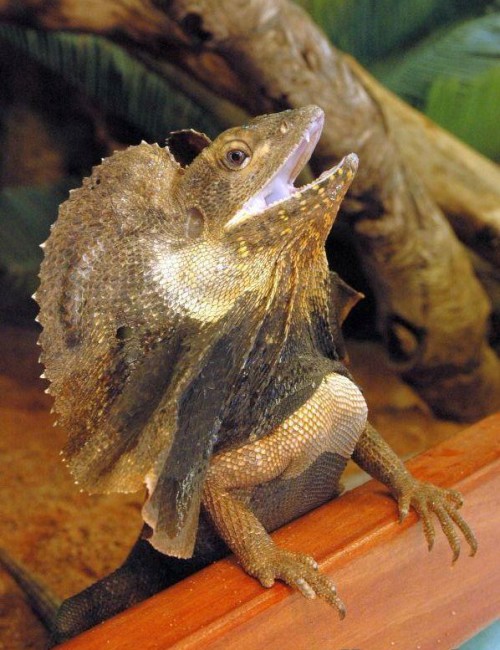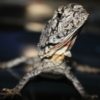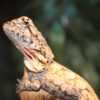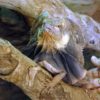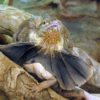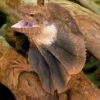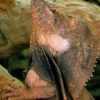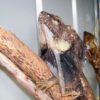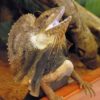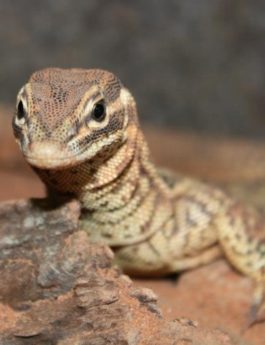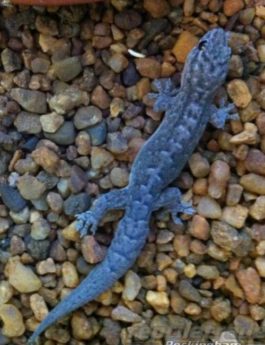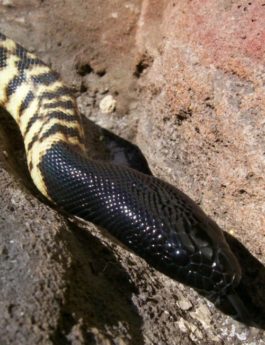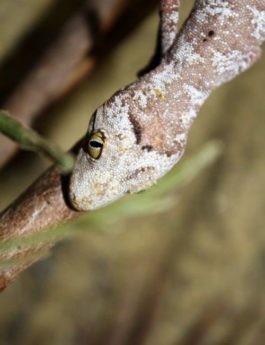Sole member of genus. Chlamydosaurus kingii: SVL 258mm Very distinctive with a loose frill of scaly skin attached to neck. At rest it folds like a cape over the neck and shoulders; erect, it stands at 90 degrees to encircle the head and neck. Frill colour variable; WA and NT lizards have red or orange in the frill while those from Qld are grey. Arboreal. Seldom encountered during dry season. Frequently seen during wet season. If confronted, the frill is suddenly erected and the mouth gaped, presenting a startling change in colour and form. The frill is also erected during social displays. Will slide slowly from view when approached.
Most of time is spent on trunks and limbs of standing trees. Frequently descends to ground after rain. Subhumid to semi-arid grassy woodlands and dry sclerophyll forests from Kimberley region, WA, across northern NT to northern and eastern Qld, extending as far south as Brisbane.
Terrarium: Frilled Neck Lizards can reach 95cm in length from head to tail, can weigh up to 500g and the diameter of the frill can reach 20-25cm. They are fairly active diurnal lizards that like to climb. Enclosures therefore need to reflect the animal’s size and type of activity. An enclosure for one adult Frilled Neck Lizard should be a minimum of 90x60x120 (WxDxH). Custom built enclosures are a good option as you can build the biggest enclosure you can in your available space.
Lighting and heating: Frilled neck lizards are diurnal, spending their days basking on tree branches, therefore they require high spectrum UVB lighting as well as an intense basking heat source. There are a number of ways to provide UVB, fluorescent 10.0 spectrum tubes or bulbs will provide UVB, a ‘daylight basking’ heat globe will have to be used in conjunction. A mercury vapour globe will provide intense UVA & UVB light, mercury vapour globes are in our opinion superior to fluorescents as it is a longer lasting globe with more intense UVB output, however they cannot be used with a thermostat so work better with a larger enclosure that will easier maintain a thermal gradient. During the day, you want to achieve a basking ‘Hot Spot’ of 38°C and an air temperature ranging from 35°C in the hot end, and down to 20-25°C in the cool end. A heat rock or heat tile should be provided as tummy heat to help with digestion, this can also be used as a night time heat source. To monitor the temperatures inside the enclosure a thermometer should always be used.
Furnishings: These animals spend a lot of their time in trees in the wild, so furnish their enclosure with tall vertical climbing branches that will support their weight. Artificial foliage throughout the enclosure will allow the Frill Neck Lizard plenty of hiding spots and coverage, a water bowl placed in the cool end, a red sand kept at the correct moister is our recommended substrate.
Food in captivity: Frilled Neck Lizards are omnivorous (meat and veg) and eat a LOT. They can be fed live crickets, large mealworms, pinky mice, roaches, cooked eggs and canned reptile food. You can also feed them a mixture of tinned cat food (no fish) with grated carrot and finely chopped lettuce.
Dust insects and pinkies with calcium supplement powder. Frill neck lizards grow fairly quickly and UVB and calcium are essential for healthy bone development or they run the very real risk of Metabolic Bone Disease. Feed hatchlings and juveniles twice a day and adults every 1-2 days.
The essentials:
- Terrarium of appropriate size
- High spectrum UVB lighting
- Daytime Basking globe
- Thermometer
- Ground heat
- Water bowl
- Substrate
- Large branches/logs
- Foliage for shelter
- Calcium and vitamin supplements

